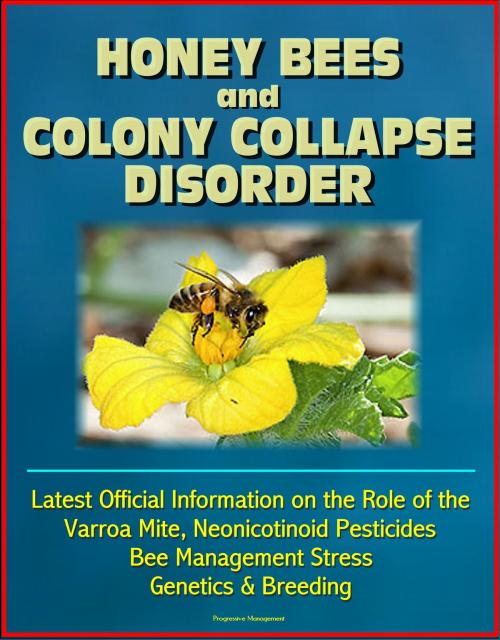Honey Bees and Colony Collapse Disorder (CCD): Latest Official Information on the Role of the Varroa Mite, Neonicotinoid Pesticides, Bee Management Stress, Genetics & Breeding
Nonfiction, Science & Nature, Science, Biological Sciences, Entomology, Horticulture| Author: | Progressive Management | ISBN: | 9781301390397 |
| Publisher: | Progressive Management | Publication: | May 4, 2013 |
| Imprint: | Smashwords Edition | Language: | English |
| Author: | Progressive Management |
| ISBN: | 9781301390397 |
| Publisher: | Progressive Management |
| Publication: | May 4, 2013 |
| Imprint: | Smashwords Edition |
| Language: | English |
This comprehensive compilation of official government documents provides complete details about Colony Collapse Disorder affecting honey bees, with the latest 2013 report on the suspected causes of the devastating problem, and earlier reports thoroughly tracing the history of CCD to it origin.
During the winter of 2006-2007, some beekeepers began to report unusually high losses of 30-90 percent of their hives. As many as 50 percent of all affected colonies demonstrated symptoms inconsistent with any known causes of honeybee death: sudden loss of a colony’s worker bee population with very few dead bees found near the colony. The queen and brood (young) remained, and the colonies had relatively abundant honey and pollen reserves. But hives cannot sustain themselves without worker bees and would eventually die. This combination of events resulting in the loss of a bee colony has been called Colony Collapse Disorder (CCD). Although agricultural records from more than a century ago note occasional bee “disappearances” and “dwindling” colonies in some years, it is uncertain whether the colonies had the same combination of factors associated with CCD. What we do know from the data from beekeepers for 2010/2011 is that CCD is still a concern.
The new report notes the following:
Consensus is building that a complex set of stressors and pathogens is associated with CCD, and researchers are increasingly using multi-factorial approaches to studying causes of colony losses.
The parasitic mite Varroa destructor remains the single most detrimental pest of honey bees, and is closely associated with overwintering colony declines. Multiple virus species have been associated with CCD. Varroa is known to cause amplified levels of viruses. The bacterial disease European foulbrood is being detected more often in the U.S. and may be linked to colony loss. Nutrition has a major impact on individual bee and colony longevity. Research indicates that gut microbes associated with honey bees play key roles in enhancement of nutrition, detoxification of chemicals, and protection against diseases. Acute and sublethal effects of pesticides on honey bees have been increasingly documented, and are a primary concern. Further tier 2 (semi-field conditions) and tier 3 (field conditions) research is required to establish the risks associated with pesticide exposure to U.S. honey bee declines in general. The most pressing pesticide research questions lie in determining the actual field-relevant pesticide exposure bees receive and the effects of pervasive exposure to multiple pesticides on bee health and productivity of whole honey bee colonies. Long-term cryopreservation of honey bee semen has been successfully developed and provides the means for long-term preservation of "top-tier" domestic honey bee germplasm for breeding. Genetic variation improves bee thermoregulation, disease resistance and worker productivity. Genomic insights from sequencing the honey bee genome are now widely used to understand and address major questions of breeding, parasite interactions, novel controls (e.g., RNAi), and management to make bees less stressed and more productive.
This comprehensive compilation of official government documents provides complete details about Colony Collapse Disorder affecting honey bees, with the latest 2013 report on the suspected causes of the devastating problem, and earlier reports thoroughly tracing the history of CCD to it origin.
During the winter of 2006-2007, some beekeepers began to report unusually high losses of 30-90 percent of their hives. As many as 50 percent of all affected colonies demonstrated symptoms inconsistent with any known causes of honeybee death: sudden loss of a colony’s worker bee population with very few dead bees found near the colony. The queen and brood (young) remained, and the colonies had relatively abundant honey and pollen reserves. But hives cannot sustain themselves without worker bees and would eventually die. This combination of events resulting in the loss of a bee colony has been called Colony Collapse Disorder (CCD). Although agricultural records from more than a century ago note occasional bee “disappearances” and “dwindling” colonies in some years, it is uncertain whether the colonies had the same combination of factors associated with CCD. What we do know from the data from beekeepers for 2010/2011 is that CCD is still a concern.
The new report notes the following:
Consensus is building that a complex set of stressors and pathogens is associated with CCD, and researchers are increasingly using multi-factorial approaches to studying causes of colony losses.
The parasitic mite Varroa destructor remains the single most detrimental pest of honey bees, and is closely associated with overwintering colony declines. Multiple virus species have been associated with CCD. Varroa is known to cause amplified levels of viruses. The bacterial disease European foulbrood is being detected more often in the U.S. and may be linked to colony loss. Nutrition has a major impact on individual bee and colony longevity. Research indicates that gut microbes associated with honey bees play key roles in enhancement of nutrition, detoxification of chemicals, and protection against diseases. Acute and sublethal effects of pesticides on honey bees have been increasingly documented, and are a primary concern. Further tier 2 (semi-field conditions) and tier 3 (field conditions) research is required to establish the risks associated with pesticide exposure to U.S. honey bee declines in general. The most pressing pesticide research questions lie in determining the actual field-relevant pesticide exposure bees receive and the effects of pervasive exposure to multiple pesticides on bee health and productivity of whole honey bee colonies. Long-term cryopreservation of honey bee semen has been successfully developed and provides the means for long-term preservation of "top-tier" domestic honey bee germplasm for breeding. Genetic variation improves bee thermoregulation, disease resistance and worker productivity. Genomic insights from sequencing the honey bee genome are now widely used to understand and address major questions of breeding, parasite interactions, novel controls (e.g., RNAi), and management to make bees less stressed and more productive.















